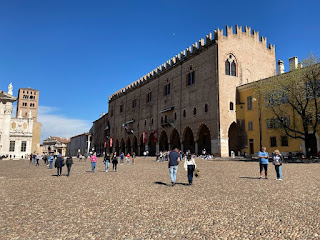First composer to have collection of his music printed
 |
| A page from an early printed collection of music by Bernardo Pisano |
Pisano - sometimes known as Pagoli - was so important in musical circles during his lifetime that he is also thought to have been the first composer anywhere in the world to have a printed collection of secular music devoted entirely to himself.
Although he was born in Florence, it is supposed that, because he used the name Pisano, he must have also spent some time living in Pisa.
As a young man, he sang and studied music at the Church of the Santissima Annunziata in Florence. In 1512, he became maestro di cappella there in addition to supervising the choristers and singing in the chapels himself.
As a favourite of the Medici family, he was appointed to sing in the papal chapel in Rome in 1514 after Cardinal Giovanni de’ Medici became Pope Leo X. While there, he also taught Francesco Corteccia, an organist and composer for Cosimo I de’ Medici.
Pisano stayed in Rome for the rest of his life, singing in the papal chapel choir, and he acquired ecclesiastical benefices from the Medici at the cathedrals of Seville and Lerida in Spain.
However, he made the mistake of returning to Florence in 1529 during the three-year period of republican government of the city. He was seized and imprisoned because he was known to have close connections to the Medici family. While he was being kept prisoner, he was accused of being a papal spy and tortured.
After the siege of Florence in 1529, the city was recaptured by papal troops and the Medici were returned to power there. Pisano was released and was able to go back to live in Rome.
 |
| Raphael's portrait of Pope Leo X, who was Pisano's friend and patron |
Madrigals were sung during the 15th and 16th centuries by groups of between two and eight voices. In 1520, a Venetian printer published ‘Musica di Messer Bernardo Pisano sopra del canzone del Petrarca’. While the pieces in the collection were not actually called madrigals, they contained features that have been recognised in retrospect as being distinctive of the madrigal genre.
The collection was made up of verses by the poet Petrarch set to music by Pisano. He was influenced by the literary theories of the poet and scholar Pietro Bembo, who was a secretary to Pope Leo X and later became a Cardinal appointed by Pope Paul III.
This publication was also the first known collection of secular music by a single composer to be printed.
Later composers who became masters of the madrigal genre are known to have been aware of this work by Pisano and to have copied some of his stylistic traits from it.
In 1546, Pope Paul III appointed Pisano as maestro di cappella of his private chapel. Among the singers in his group was a Franco/Flemish musician, Jacques Arcadelt, who was later to become famous as a madrigal composer.
Bernardo Pisano died in 1548 in Rome. He is buried in the Church of Santa Maria sopra Minerva next to the two Medici popes who had been his friends and patrons.
 |
| Giovanni Battista Caccini's Renaissance-style facade of the Basilica della Santissima Annunziata |
The Basilica della Santissima Annunziata, where Bernardo Pisano was maestro di cappella, is a minor Catholic basilica near the centre of Florence. The church was founded in 1250 by the seven original members of the Servite order and is located in Piazza Santissima Annunziata. In 1252 a friar was commissioned to produce a painting of the Annunciation for the church. He was said to have despaired about being able to do justice to the face of the Virgin and eventually fell asleep while working on it, but when he woke again the painting had been miraculously completed. He attributed this to the work of an angel. The painting has since attracted many pilgrims to visit it, including Pope Alexander VI, who gave a silver effigy to the church. It has since become the tradition for brides in Florence to visit the church to leave their bouquets there.
Stay in Florence with Expedia
_-_Inside_HDR.jpg) |
| The Gothic interior of the Basilica di Santa Maria sopra Minerva in Rome, where Pisano is buried |
The Basilica di Santa Maria sopra Minerva, where Bernardo Pisano is buried, is in Piazza della Minerva in Rome. The name of the church is derived from the fact that the original structure was built directly over the ruins of a temple dedicated to the Egyptian goddess Isis, that had been wrongly ascribed to the Greek/Roman goddess Minerva. It is located to the east of the Pantheon in the Pigna rione of Rome in the ancient district known as Campus Martius. Dominican friars began building the present Gothic church structure in 1280, modelling it on Santa Maria Novella in Florence. In 1431 the church and adjacent convent was the site of a papal conclave, when 14 Cardinals sitting in the sacristy elected Pope Eugenius IV. After his death, a second conclave was held there in 1447 when 18 Cardinals elected Pope Nicholas V. The church houses a marble sculpture by Michelangelo, Cristo della Minerva, representing the figure of Christ carrying the cross, which is located to the left of the main altar.
Book a Rome hotel with Hotels.com
More reading:
How the madrigal genre influenced the composer Monteverdi
The madrigal writer also known for a brutal murder
The Medici musician who invented the madrigal comedy
Also on this day:
1492: The death of Renaissance painter Piero della Francesca
1812: The death of Ascanio Sobrero, the chemist who discovered nitroglycerine
1935: The birth of tenor Luciano Pavarotti
2006: The death of film director Gillo Pontecorvo







.jpg)




















